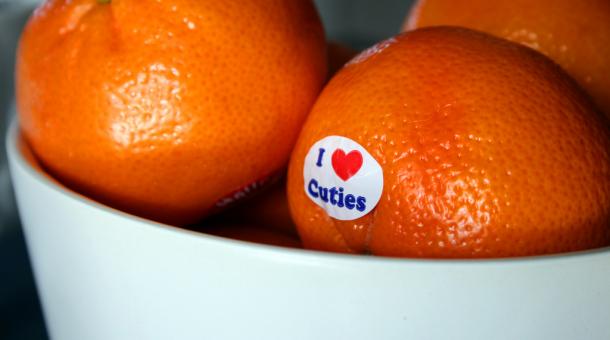I listen to NPR at the house and was surprised to hear this story run last Monday on Marketplace.
http://www.marketplace.org/topics/life/food-and-drink/how-cuties-marketed-mandarin-oranges-fruit-brand
How Cuties marketed Mandarin oranges from fruit to brand
 Listen to the story here
Interview by Kai Ryssdal
Listen to the story here
Interview by Kai Ryssdal
Marketplace for Monday, April 2, 2012
Kai Ryssdal: I say citrus, you probably think oranges and lemons, limes maybe, and grapefruit, right?
More and more, though, the citrus that we're reaching for in the produce section are small, seedless, easy-to-peel and come in a five-pound bag. They're technically Mandarin oranges -- more commonly known, though, as Cuties.
Sarah Rich writes the Design Decoded blog for Smithsonian.com, where she recently explored the mandarins' journey from fruit to brand name. Sarah Rich, welcome to the program.
Sarah Rich: Thanks for having me.
Ryssdal: So, design of oranges, really?
Rich: Really, yeah. I was kind of intrigued by an advertising campaign towards the end of 2011 by a brand called Cuties that makes mandarins. And their tagline was 'Kids love Cuties because Cuties are made for kids.' And I kind of thought, 'Made for kids,' I wonder what's behind that?
Ryssdal: This marketing campaign you looked at, it's all about the physical and structural properties of this fruit. Tell us more about that.
Rich: There were four or five different little short spots that were put out for this. One of them is 'Know why Cuties are small? Because kids have small hands.' And one is, 'Know why Cuties are seedless? Because kids hate seeds.' And so it's all setting it up to be: structurally, this thing is great for a child.
Ryssdal: Which is great, because you want kids to eat fruit and be healthy and lord knows we need more of that in this country, but it's just a little depressing and cynical that that's the way the marketing goes.
Rich: Well you know, it's an effective marketing campaign. I mean, to me what was also interesting was just the fact at all that fruit is being sort of branded and marketed. But now I think in a similar way to the fact that people call tissues 'Kleenex,' people might start calling mandarins 'Cuties,' because that's the brand that's most predominant. The other way that they're being treated like a consumer packaged good is that you find things like coupons you can clip in the paper for Cuties brand specifically. You don't find clippable coupons for just any orange, so it becomes kind of a different cycle of the way that people are paying for it.
Ryssdal: Right. And it's also a little bit, so the Cuties are packaged and presented in such a way that there is a surface on which to put the branding, as opposed to those teeny little barcode stickers that you can't read anyway.
Rich: In order to brand really effectively with a fruit or vegetable, you do have to add packaging. There was a ridiculous example a year or two ago where Del Monte decided to put their bananas into a cellophane, individual cellophane wrapper. Everyone calls bananas the perfect fruit because they have this natural packaging, but how are you going to get enough of your brand onto it without this additional surface on which to put your logo and a tagline?
Ryssdal: What's the difference between a tangerine and a Cutie, one of these -- oh clementines, didn't they used to be called clementines?
Rich: Clementines. Yeah, the Citris reticulata Blanco is the [scientific] name for these things, and the numbers are pretty vast and the differences are somewhat subtle, but the characteristics that they're going for, including the color of the rind, the better it will sell; the ones that are smooth versus bumpy are going to be better. So you could find many different names of these things, but the differences generally are going to be kind of physical versus in terms of taste.
Ryssdal: Yeah, I always thought bumpy peels peeled easier than smooth peels, or is that just me?
Rich: You know, I think it has more to do with, they call it a zipper fruit -- it's meant to explain the sort of looseness of the skin around the fruit. And that's what makes it easy to peel, is there's sort of a separation between the fruit itself and the peel, so it kind of pops out like that.
Ryssdal: Did you ever think you were ever going to know this much about citrus?
Rich: No, it was quite a rabbit hole, from the TV commercial to all the things I learned.
Ryssdal: Yeah. Sarah Rich writes the Design Decoded blog on Smithsonian.com. Sarah, thanks a lot.
Rich: Thanks so much.














